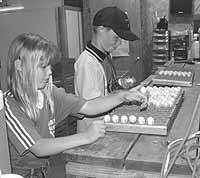It has been a busy spring for the Hatt family of Green River. They have been gathering eggs out at the ranch and transporting these eggs into town to the bird hatchery.
Hatchery owner, Royd Hatt said, “It takes 24 days for the eggs to hatch. They are placed in trays with the pointed side of the egg facing down. We hatch every Wednesday. After the eggs are set they are placed in the incubator. The trays are rotated so the eggs will all develop evenly. Seventy-five to 80 percent of the pheasant eggs will hatch and 90 percent of the chukkars. We incubate approximately a half a million eggs per season and hatch 400,000 chicks. Everyone participates in the gathering of the eggs and during our peak time we gather 7,000 eggs per day. Pheasants will lay every day and a half during their laying season.
“We bring the eggs in and wash them. We have a machine that brushes and washes them. After they are clean they are disinfected. We hatch through the end of July. There are 200-250 chicks in each tray. We have been operating the hatchery for 15 years now. It is a family operation. My wife Toni and children, Ren, Crosby, Parker, and Megan all pitch in. My parents LuJuan and Rey Lloyd operate the ranch. Kedric Bayles also works with us.
“The eggs are kept cold at 55 degrees until they are ready to be set. This keeps them dormant until they are ready. We pull them out on Friday so the eggs can warm to room temperature before going into the incubator.
“We sell all but 50,000 birds which we raise for the ranch. Everything we will hatch this year has already been sold. Most of the people will come here and pick them up, although we do some overnight shipping. We also keep 10,000 hens which we sell as adults or harvest.
“The chicks are very tender for about 10 days, they have a hard time controlling and maintaining their body heat while they are still in the downy stage. They are kept in brooder houses where the temperature is kept at 100 degrees and then dropped five degrees a week. By five weeks of age they are placed in flight pens where there are feeders and water,” said Royd.
Full time ranch employee, Richey Hansen is also trying his hand at raising some of the more exotic pheasants. “I’ve been working at the ranch for four years. I help hatch hens for breeders and also to fill contracts. I take hunters out at the ranch as well. The hunting season runs from October to the middle of March. The hens start laying around the end of March. Their peak time is in April. Their pituitary gland tells them when to start laying by the amount of daylight. Most of the birds we ship are mixed, but some people do request all roosters or all hens.
“In the first 10 weeks of the hens life we will lose below 10 percent of the chicks. We like to keep it below that and most of the time we can. If they overheat or are stressed then sometimes we lose them. Sometimes they catch a virus, too. Royd is really good at doctoring the birds. So our survivial rate is really high. The birds are fully grown in about 16 weeks.
“Things are dry out to the ranch and we hope we can keep the cover for the birds. The water for the birds on the ranch comes from the San Rafael River. With the drought, we hope we don’t have to haul water out to the ranch for the birds.
“Royd is working on some breeder houses on his property here in town and in the near future we will be able to gather the eggs in town instead of at the ranch. This will save time and the eggs won’t have to be transported so far, said Hansen.
Hansen also said moving the egg operation into town will allow some local high school students to have part-time jobs gathering eggs. The Hatt ranch has been in operation since 1975.
Hatt’s Hatchery on the Run As Egg Gathering Continues

